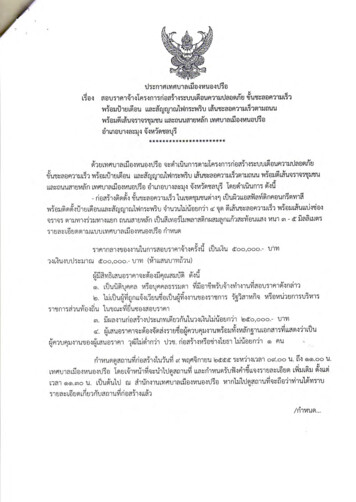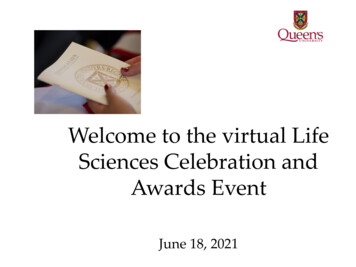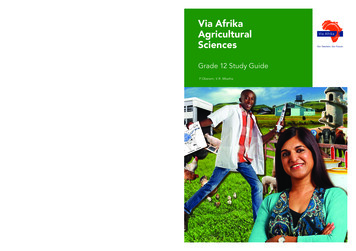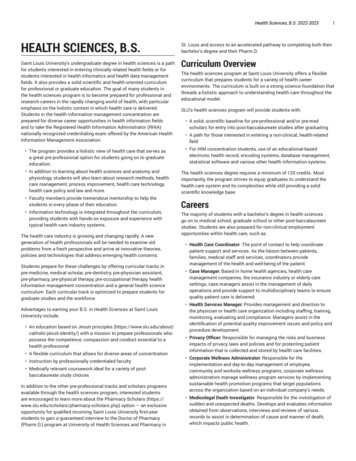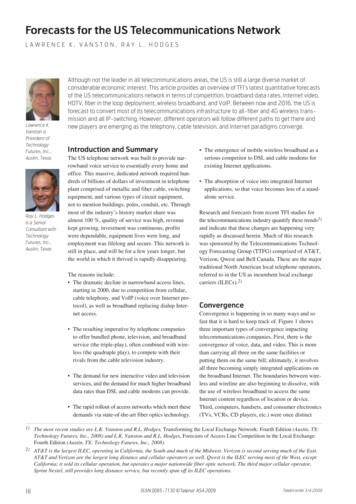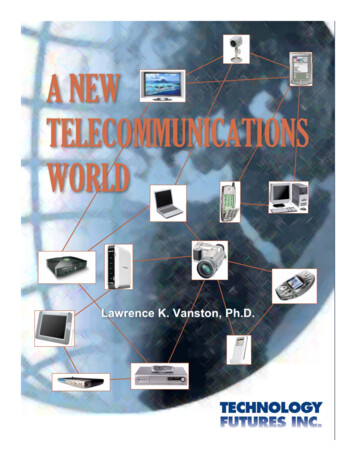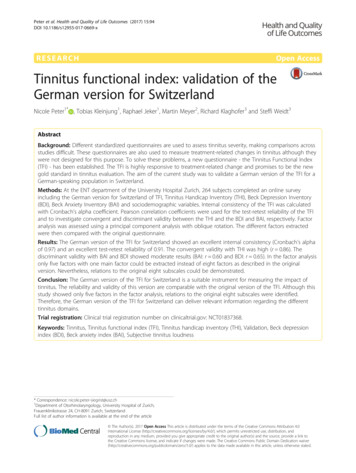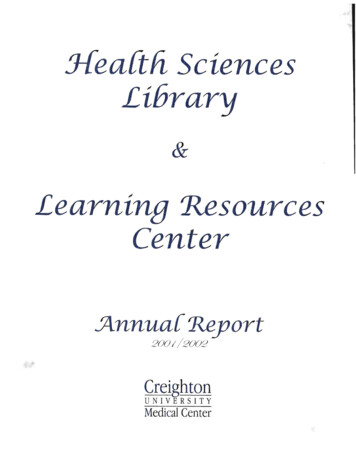
Transcription
IIIIIIIIIIIIIIIIIIIJ{ea{tfi SciencesLibrary&Learning ResourcesCenter nnua{ 1{eyort2001/9002CreightonUNIVERSITYMedical Center
IIIIIIIIIIIII.IIIII'I
J-{eaftli Sciences Li6rary&Learning 1{esourcesCenter'I'a6fe of ContentsLIBRARY STAFF1MESSAGE FROM THE DIRECTOR2CIRCULATION & INTERLIBRARY LOAN REPORT6LEARNING RESOURCES CENTER REPORT8NATIONAL NETWORK OF LIBRARIES OF MEDICINE LIASONPROGRAM10REFERENCE SERVICE REPORTS11TECHNICAL SERVICES REPORT13STATISTICAL SUMMARY15LIBRARY DONORS16HEALTH SCIENCES LIBRARY ADVISORY COMMITTEE17
LIBRARY STAFF200112002. AdministrationDirectorStaff.A James BothmerC nnie Winters.National Network Libraries MedicineDennis HaackCirculationfInterlibrary LoanHeadStaff.Patricia MeevesMadonna KnudsonKarlanne HannaTim GlickJuan GuzmanCynthia AbelLearning Resources CenterHeadStaff.Jane RomackDiana BooneEmma McCruelMatt StanleyReferenceHeadRichard JizbaSha\vn ArnrnonJudi th Bergj 0 rdStaff.Jeanne BurkeBryan StackTechnical ServicesHeadStaff.Nannette BedroskyErin BauerJane FishkinMarcella Dial
. . . -"""- -a\'\ii. , . . ljp)Message from the DirectorJim BothmerAn annual report by definition is a look back at the previous year's accomplishments andchallenges. It is also a look forward to the goals and challenges that the library faces. Changehas been constant since this library opened in 1977, but our core values have not changed. Wecontinue to collaborate and innovate and provide excellent service. At the same time we payattention to the rapidly changing information world in which we live and strive to balance theinformation needs of all of our clients as we move toward a digital library. As with each lookback and view to the future, the highlights are based on the hard work and dedication of anexcellent staff and the strong support from the university administration and faculty.May 19,2002 marked the 25 th anniversary of the Health Sciences Library/LearningResources Center (HSL). As HSL prepares to celebrate its 25 th anniversary in August 2002 it isa good opportunity to review the differences of the library between 1977 and 2002.A comparison between 1977/78 and 200112002 is revealing:1977/78MEDLINE Searches:Reference Questions:Interlibrary Loans borrowedInterlibrary Loans loanedPhotocopies made1,0613,706638292299,91567,624Volumes at FY end (June 1977)Print Serial Titles received1,275Electronic JournalsoMultimedia programs at FY end 2,422Staff21.53,361Primary Users673User Seating34,000Square n 425237,0641,1921,65112,1202210,286over 60034,000293,96997,6406,646Circulation and MEDLINE searches actually declined, which is a direct reflection on thegrowing emphasis on electronic information. Library materials borrowed and loaned increasedsignificantly, which reflects a large increase in the primary population served as well as greateramount of information available. Print journals remained relatively static but there were no e journal in 1977/78. The number of library staff members remained static but the user populationtripled. An increased role in the education of the user population is also reflected in the ten-foldincrease of "students".We increasingly strive to create a virtual, digital library. However, the concept of adigital library is still a dream that has not yet come to fruition. Digital libraries do not yet existexcept as online collections; and online collections do not yet function like conventionallibraries. Digital collections lack several critical components that make up a library: servicecomponent, preservation strategy, and the ability of searching across collections at least at arobust level. All of these aspects exist in the conventional library and are critical to the successof the digital library.fiJl\
In an increasingly "virtual society" the perception that print is declining is something thatalso has to be addressed. The very real fact is that print is not declining nearly as rapidly asthought just a few years ago. Whereas the creation of and access to digital collections continueto explode there is a threat to the historical record posed by current developments.Collaboration between IT staff and librarians needs to be implemented in order todevelop workable models of digital archiving and preservation of the printed word.Howard Besser defined four core missions,of a library: "physical place, focus spot forcontinuous educational development, mission to serve the underserved, and a guarantor of publicaccess to information." (Howard Besser, 1998. "The Shape of the 21 st Century Library," In:Milton T. Wolf, Pat Ensor, and Mary Augusta Thomas (editors). Information Imagineering:Meeting at the Interface. Chicago: American Library Association, pp. 133-146.)To continue this stream of thought it is appropriate to define what a library is. Librarieshave always been more than just collections. Important, even critical roles include service andstewardship over a collection, sustainability of services and physical plant, and the ability tolocate and retrieve materials outside a library's collection. These factors combined with anethical tradition of upholding free speech, privacy, and equity in access to information definewhat a library is.The financial support from the university for the library's materials continues to allow usto maintain our present collection. Collaboration is still a key goal. Schools, departments, anddivisions within the Creighton University Medical Center spent over 434,000 for books andsubscriptions during the last fiscal year (2001/02). The real likelihood of wasteful duplicationin budgetary restrained times makes collaboration in this area critical.The short-term goals for HSLlLRC are sustainability of present services and resourcesand creating a balance between acquiring print resources and acquiring digital resources. Thelong-term goals are a move to the construction and creation of the digital library. However, it iscritical to remember that libraries are not merely collections of materials. Digital collections willnot truly become digital libraries until they incorporate the services and ethical traditionsdescribed above.,Finally, the comparison of the composite library and the Health Sciences Library revealsthat we do more with less, which is not necessarily a positive achievement.National Composite LibraryHSL38 FTE staffRecurring Expenditures: 2,784,778Materials budget of 1 ,216,91 7Per capita expenditure by the library of 334Open 98 hours a week43,574 square feetSeating capacity of 415Served 279,667 people in the last yearProvided 149 education sessionsAttended by 1,51122FTE 1,536,776 718,964 271 per capita104.5 hours35,000 square feetSeating capacity of nearly 600Served 273,462Provided 337 sessionsAttended by 2,939IfiIf:1
Highlights and Accomplishments 2001102Collaboration Managed and maintain a proxy server for Reinert Library and Creighton UniversityMedical Center schools and programs. Managed databases for all Creighton University Medical Center schools and programsand the hospital. Worked with Dr. Erika Kirby's Senior Communications class to survey faculty andstudents to help determine whether the library is meeting their needs. Continued to handle the mail for Media Services West, the Drug Informatics Center, andthe School of Pharmacy and Health Professions computer support office in the BICBuilding. Upgraded the computer lab with student technology money.Collections Increased the number of electronic resources Implemented JournalWebCite, a system for managing electronic resources. Defined policy for choosing electronic over print resources. Began extensive inventory of entire collection. Began process of weeding %" videos.Staffing Dedicated fountain in memory of Ruth Witkovski, colleague and friend. Upgraded serials coordinator position and recruited an electronic serials librarian. Recruited a Regional Medical Library coordinator to create models of information accessfor health practitioners serving inner city populations and for the inner city populationsthemselves. Conducted an all staff planning retreat.Outreach Attended general faculty meetings of each school. Met with all course and curriculum directors and coordinators. Delivered information in the most efficient way possible through collaborative effortswith the other Creighton University schools, departments, and libraries and with local andregional health sciences libraries. Collaborated with the School of Pharmacy and Health Professions to deliver services tothe new students in the web based distance educational program. Began attending select Grand Rounds in the School of Medicine and created a webresource page to support the information needs of the participants.Building Improved facility infrastructure, including new signage, new furniture, and new lighting.
Contribution to Jesuit-Catholic Mission - The HSL daily lives the credo of the Creighton University Jesuit-Catholic mission. Thelibrary's Mission Statement specifically states that we will "Contribute to CreightonUniversity's mission by becoming a center of excellence on campus."Quest for Diversity - 33% of support staff is ethnically diverse. , - Responsible for coordinating the National Network of Libraries of Medicine's (NNLM)program to deliver information to health practitioners serving minority and underservedpopulations (see NNLM account elsewhere in this report).Challenges and Goals (or 2002103 and beyond - - -The two greatest challenges for the HSL are to secure and increase stable and solidfunding to assure adequate access to information and to provide fair compensation to itsexcellent staff. Those are really challenges to the university as much as to the library.Retaining rights to scholarship at the institutional level while at the same time making itaccessible and available to researchers and patient care providers on and off campus.Access to information is increasingly problematic as the number of publishers shrinksthrough closures and acquisitions by other companies. There is a very real threat ofmonopolies that can dictate prices. However, information grows at astonishing rates andidentifying the quality over quantity is a challenge in itself.Define "library as place" and secure funding to maintain and improve the building.Technologic changes have also impacted physical facilities. We celebrate our 25 thanniversary this year yet the physical improvements to the library's infrastructurecontinue to lag behind. Gradually new furniture is added to replace 25-year-old items butthe library's budget simply is inadequate to do major improvements in a systematicmatter. Such things as new carpet, new signage, and new lighting are critical needs thatcontinue to require new funding.Define with university administration the library's role within the Creighton UniversityMedical Center. Libraries have a mission to be a portal to information for their primaryconstituency and traditionally have not been cost centers.Work with Development to create fundraising initiatives and to increase the endowmentfor the library.Create and manage an electronic image database by working with InformationTechnology, Reinert Library, and Law Library to develop an institutional repository fordigital archives. HSL will also implement Hyperion, an image management system ofSIRSI to manage CUMC departmental newsletters in a digital format.Meet with all health science schools' course and curriculum directors and coordinators.Implement an outreach plan to Creighton University Medical Center, especially thehospital and clinics.Collaborate with the Physical Therapy program to write a grant providing resources andservices to the Winnebago and Omaha tribes.
Develop a management system for electronic journals, which includes fullyimplementing JournalWebCite and fine-tuning selection and retention criteria for journals(electronic and print).Continue to contribute to the Jesuit-Catholic nature of the University.Continue to strive for diversity in services and staffing.CIRCULATIONIINTERLIBRARY LOANPat MeevesThe biggest change that occurred in the Circulation department was that Interlibrary Loan wasmoved from the Reference Department to the Circulation Department. The CirculationDepartment was already an extension of Interlibrary Loan in its document delivery service andchange was implemented to enhance this flow of service. A software program (Quickdoc) wasinstalled that allows the library to organize and track Interlibrary Loan requests. All existingborrowing records were transferred into the current full version of Quickdoc. CreightonUniversity Medical Center also joined the Electronic Fee Transfer Service (EFTS), whichstreamlines the billing process with regard to borrowing and lending from other libraries. Thepresent version of Quickdoc makes it easy to add and delete libraries from EFTS membership,change EFTS billing charges, and create each month's billing of members. Staff is responsiblefor proofreading all EFTS lending we've done each month, which includes ensuring that we'vemanually loaded any non-Docline requests we've filled for or borrowed from EFTS membersinto Quickdoc, and export all of the filled EFTS lends into a file, which is then sent via e-mailattachment to the EFTS home site at the University of Connecticut.We inventoried approximately 2/3 of our monograph collection, subsequently identifying 500items as missing. We corrected multiple errors during this process. In response to the multipleerrors found during inventory process we developed a Call Number Verification Project, whichwill reduce the size of the inventory error reports.The "In Serials" project is now 95% completed. The necessity of this project stems from ourmove to the Sirsi system, when our records did not transfer in a readable format for our users.We converted to a new software product (DocuTek) for handling electronic reserves. Thissoftware enables instructors to make available electronically, course material to studentswherever they are. Over the course of the year there were 63 courses available which comprised731 documents.We continue to strive for a balance between space and efficiency. We have moved over 75% ofour pre-1960 journal collection to offsite storage, and we will retrieve materials on an as neededbasis. The turnaround time for retrieval of requests is 24 hours.We migrated to a JayBucks cash register. This enables us to use the students JayBucks cards forcash transactions. We are also able to run product reports, which itemize all cash transactions.GOALS FOR 2002 - 2003 Complete the inventory of the textbooks and continue the process with our journalcollection.li:Jf.1
Complete the shifting of pre-1960 journals to off-site storage Continue monitoring records to ensure accuracy and ease of reading our holdings for ourclients. Streamline the billing process in Circulation and ILL To encourage our faculty to access our electronic reserves so that they too can putmaterial on reserves for their students.Use of Seminar RoomGroupsIndividuals2542493Reserve Materials Processed571Use of CollectionPrint Reserve CollectionExternal Print.External AudiovisuallMediaPrint Materials f Produced Photocopies22,793INTERLIBARY LOANSITEMS REQUESTED FROM OTHER LIBRARIESType of MaterialsSerialsMonographsItems Received (Filled by Others)Items Not Received (Unfilled by Others)'. 20262201184180"Average Turnaround Time5/7 daysITEMS REQUESTED BY OTHER LIBRARIESType of Materials RequestedSerialsMonographsAudiovisualsType of Materials ProvidedSerialsMonographs404419433,Average Turnaround Time27407124 hours
Learning Resources CenterJane Stehlik RomackClient Benefits: We continued to teach access skills with Sirsi and the Internet as well as identifiedresources and led clients to pertinent imagery to support their projects. Resources were provided forclients studying for State Board exams. Participation in orientations for the new students and facultyin Health Sciences and attendance at curriculum and campus meetings helped us collect informationimportant to customer services enhancement. We enriched the LRC collection with new media andfeatured weekly exhibits in the LRC on some of the newest CD and Video programs. The LRC WebPage was enriched and the "Hot Picks" now include the following categories: Bioterrorism; CaseStudieslMaterial; Copyright; Imagery in Health Sciences; LRC Topical Bibliographies: PortalsSignificant to Health Sciences; Tutorials-Health Sciences; Tutorials-Computer Skills; Special WebLibrarieslDatabases; and Webcasts.New services: In January, four laptops were made available to our clients with student technologymoney. The equipment was borrowed 320 times by the end of June. Wireless access was introducedthroughout the LibrarylLRC, and infrared printing was instated in the fall, a particular benefit to thepharmacy students. In support of Health Sciences faculty, we arranged for our LRC Cluster Rooms tobe used for small group instruction. This was a great benefit to Dr. Amy Hadad and her associates, andcontributed to student curriculum achievement. With the thrust toward small group collaboration, theCluster Rooms have become an even greater asset to curriculum objectives for all health sciencesschools. Usage increased from 10,000 to 20,000 users. Using the new capabilities ofSirsi we createdmore personalized bibliographies for faculty, staff, and students than ever before. Outreach to non Creighton clients included a Radiologist in Ohio who needed help in locating resources; a Physicianstudent needing media related to OBGYN; an Instructor for the Deaf Interpreter Program atMetropolitan Community College who needed closed captioned videos for patient education; a patientin Omaha needing help in finding resources on a brain tumor; and a Coordinator in Omaha developinga Women's Crises Center for Spanish Speaking Women. "Collection Development: A listing of% inch U-Matic videos was mounted on the LRC web page.Creighton University Medical Center faculty was consulted to help determine the value of these 3/4 inch video programs. An attempt will be made to save any classic material that is designated asuseful. Regarding new acquisitions, a few of the titles acquired included: PULSEEmergencylMedical Update; Digital Atlas of Human Skeleton; Pediatric Cardiac Auscultation;Interactive Electrocardiography; Bones of the Skill. The Kaplan Learning Center collection wasentirely updated with 177 new videos. With a goal of becoming a more virtual LRC, ongoingcommunication with authors, producers, vendors, and technology experts continues to be interestingand positive. Many issues need to be resolved before commercially produced collection can bedigitized for to the web.LRC Computer Lab: It was an interactive and very busy year in the computer lab, which iscomprised of 30 stations. We observed a phenomenal increase in printing and observed increasedcollaborative activity of students.liJi:.1
Facility Improvements for the year: We came out of our cave! The new lighting was installed andmade a major impact on the total environment. New chairs were added to the Lab, and fresh paintimproved our overall appearance as we move toward the 25 th Anniversary of the BIC.LRC Staff Visibility: The LRC participated in all orientations for new students. LRC Staff was visibleat on campus and off campus events. We were also involved in student recruitment efforts--theMillard West High School Career Fair for 2,000 students held in October, and in January we hosted 70minority students from Omaha Public Schools at our annual LRC Expo for Focus on HealthProfessions Program. LRC associates served on a variety of committees-HSL/LRC ContinuingEducation; Collection Development; Web Team; Sirsi Acquisitions; Sirsi Cataloging; Hyperion; LabAdmin; School of Dentistry Curriculum Committee; SLA Chapter Archivist; SLA Chapter Treasurer.Appreciation: It has been a most successful service year-my thanks to the LRC staff: Diana Boone,Emma McCruel, and Matt Stanley.Goals: Acquire web-based programs whenever feasible; seek permissions from vendors to streamprograms presently held by the LRC; participate, teach, and promote the value of services to ourclients; work toward a virtual LRC.Number of ItemsVideosSlide ProgramsCiba SlidesAudiocassettesAudio Digest.ModelsKitsVideo DiscsVideo JournalsKaplanCD-ROMSNCME"Use of Cluster RoomsUse of Computer Lab2334147761261641076882113417721719119,60780,966
National Network of Libraries of Medicine Liaison ProgramDennis HaackIn 2001 the Creighton Health Sciences Library became the designated home for a liaison of theNational Network of Libraries of Medicine (NNLM)."The National Network of Libraries of Medicine (NNLM) is a program of the National Library ofMedicine (NLM) aimed at promoting NLM's broad mission of advancing medicine andimproving public health by I) providing health professionals with equal access to biomedicalinformation; and 2) improving the public's access to information thus enabling them to makeinformed decisions about their health. Eight Regional Medical Libraries (RMLs), located acrossthe nation and funded by NLM, work to promote and coordinate the activities of the network andits members.In the May 2001, NLM awarded the five-year RML grant for the Mid-continent Region- Nebraska, Kansas, Missouri, Colorado, Wyoming and Utah-- to the University of Utah in SaltLake City. Rather than working from one centralized institution like other RMLs, Utah's plancalled for the strategic distribution of state liaisons and special project coordinators at medicalresource libraries throughout the various states. The Utah proposal included the provision of aspecial project area to address the information needs of inner city health professionals andminority populations. Located in a large, urban and ethnically diverse community, the CreightonUniversity Health Science Library was therefore subcontracted to provide a liaison that wouldserve as coordinator ofInner City Services. The Inner City Services liaison, Dennis Haack, wasemployed and began work on the project in October.As an NNLM liaison Mr.Haack's duties have included exhibiting at national and localconferences, promoting the services of the National Library of Medicine (NLM) such asMEDLINEplus, Clinical Trials and PubMed to health 'professional and consumers, as well asmembership in the Network to libraries and health organizations. At national and localconferences, the liaison has distributed materials and/or performed live demonstrations ofPubMed or MEDLINEplus to approximately 1,337 individuals.On the local level, Mr. Haack has meet with Creighton faculty, community members, publicschool teachers and nurses to discuss areas of needs and possible collaboration. Mr. Haack hasworked with coordinators of Creighton's successful pipeline programs (i.e. HCOP and HPPI),Barb Slattery and Brenda Bell to make contacts with the public schools. Mr. Haack has providedsmall group presentations on health and health careers resources to 149 junior and senior highminority students. Mr. Haack has also provided talks to 26 health professionals, social workersor librarians at committee and other meetings.IiJii.1
Reference ServicesRichard JizbaEducational activities, changes in technology and systems, and new projects kept the Referencestaff quite busy again this year. Although our staffing has remained stable, the Interlibrary LoanService was transferred from Reference to Circulation, in order improve coordination with thepull & copy service and to provide the Circulation with additional staffing options.We continue to offer a full range of educational opportunities to our students and faculty:individual instruction, workshops, guest lectures, credit courses, orientation tours, and print andweb based information. While we work mostly with students and faculty affiliated with theCreighton Medical Center, we also work with high school students in programs such as the HighSchool Enrichment Program and the general public who come into the library needing assistancetracking down information. This spring we hosted our first library intern, a student in thedistance education program at the Graduate School of Library and Information Science,University of Illinois.In response to the tragic events of September 11 th and subsequent events, we hosted several CDCteleconferences on bioterrorism. We also produced print and web based guides to information onthe health aspects of biological, chemical, and nuclear terrorism.As always, we had to deal with changes in technology and computer systems. We continue tohost the EZProxy service, which provides remote access to our licensed resources. This is aservice we provide to the entire University, not just the Creighton University Medical Center. Inresponse to concerns from students about the number of logins they had to remember weconfigured EZProxy to accept both Bluejay and Active Directory logins in addition to the librarybarcode. In addition we have completed the move to Active Directory for all Reference staff.We continued to add web-based resources to our collection. With a stable collection of databasesto the journal literature, the focus remains on handbook or encyclopedic types of works. Amongthe titles added this year were Clinical Pharmacology and eMedicine. The latter filled a criticalgap in our collection of web-based disease oriented products.We also beta tested the latest version WebSPIRS, the interface for our bibliographic databasecollection. We think this product includes a number of significant enhancements, but we haveconcerns over changes to the pricing model.Finding new ways to serve our clients or simply reminding them of the services we offer is anongoing challenge. Thus the Outreach Coordinator visited many of the local Creighton Clinics toupdate them on the services we offer. This spring we created a web resource page to support theGrand Rounds and seminars presented at the Creighton University Medical Center. .p
Our goals for the coming year are:To explore new formats, procedures and teclmiques for improving and explaining oureducational services. In particular we want to redesign and update the computer skills course forfirst year dental students. We also want to develop and implement a small group instructionmodel to support course related training need throughout the health sciences curriculum.To review our use ofOvidfWebSPIRS as our primary platform for access to bibliographicdatabases.To continue to develop the Grand Rounds and Seminars Resources web page in support of theseactivities throughout the Creighton University Medical Center.To enhance our outreach and liaison efforts to Creighton's satellite clinics.To manage our collections of print and electronic reference resources for quality and relevancyin order to serve the educational, patient care, and research needs of the Creighton UniversityMedical Center.COMPUTER SEARCH REQUESTS BY AFFILIATIONMedicineNursingPharmacyDentistryAllied HealthOtherTotal.EDUCATIONAL ACTIVITIESTotal Number Workshop SessionsTotal Number Workshop HoursTotal Number Participants215174522071296677077716646CIi2\.,12 t
Technical ServicesNannette BedroskyThe past year was one of change. The year began on a sad note. Ruth Witkovski, 24-year employeesuccumbed to a lengthy battle with cancer.Her position was upgraded and changed to Serials/Electronic Collections Librarian to reflect theconstant changes in the serials industry. A new Serials Assistant was also hired. Erin Bauer was hiredfor the newly created SerialslElectronic Collections Librarian position and Marcella Dial was hired asthe Serials Assistant.With the creation of the SerialslElectronic Collections Librarian position all the e-journalresponsibilities were consolidated into one position. In the past at least five staff members fromdifferent library departments were involved in e-journals. The growing electronic journal collectionsare much better organized and maintained. A new e-journal management system, Journal WebCite(JWC) was purchased to help organize our collection. JWC allows us to easily find and change bandlinks, changes to publishers, as well as combine all our e-journals in one database. A major goal for2002/03 is to input the entire e-journal collection into JWC.The past year was one of learning and training for the Technical Services Department. As lead SystemAdministrator for the campus automated library system, SIRSIICLIC Nannette Bedrosky wasresponsible for communicating and resolving problems between the campus libraries and our vendor,SIRSI. Department staff has been busy learning and refining their SIRSI job skills.In March a long awaited upgrade to SIRSI occurred. Much needed improvements in the Acquisitionsmodule and Reports module were included.Erin Bauer attended the annual North American Serials Interest Group (NASIG) meeting, whichfocused on new trends in serials issues especially e-journals. Jane Fishkin attended an annualAcquisitions meeting in May, which focused on acquisitions issues especially e-books. NannetteBedrosky attended the annual SIRSI Users group (DUGI) Conference in May, which focused on issueswith the automated library system.
Goals for the coming year include:Catalog and add monographs from Mary Lanning Hospital and Alegent hospitals to our online publicaccess catalog, CLIC;. Evaluate new vendors for serials collection;Clean up the serials database in CUC, the online catalog;Evaluate the changes in ScienceDirect;Plan for the 2003 upgrade of our library system, which includes an equipment upgrade;Plan and implement a Hyperion project by digitizing and organizing newsletters from CreightonUniversity Medical Center departments and make them available on the web.NEW MATERlALS CATALOGEDBooksSerialsAV's104910041C
A software program (Quickdoc) was installed that allows the library to organize and track Interlibrary Loan requests. All existing borrowing records were transferred into the current full version of Quickdoc. Creighton University Medical Center also joined the Electronic Fee Transfer Service (EFTS), which '.
